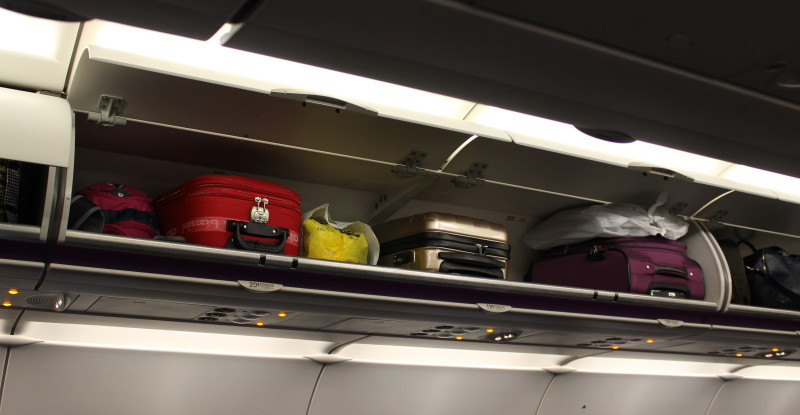 After yet another aircraft emergency evacuation with passengers bringing personal items and carry-on baggage, it is time for the aviation industry to stop the pretence that panicked passengers will leave their luggage behind when evacuating.
After yet another aircraft emergency evacuation with passengers bringing personal items and carry-on baggage, it is time for the aviation industry to stop the pretence that panicked passengers will leave their luggage behind when evacuating.
The latest incident on board a Transavia Boeing 737-800 on 28 October at Amsterdam Schiphol involved an evacuation after arriving from Seville. The main landing gear of the aircraft appeared to catch fire during taxiing. Passengers were evacuated using the emergency slides and, it seems, the overwing exits.
Transavia Boeing 737-800 (PH-HXG, built 2017) experienced a fire in the main gear while taxiing at "Bravo" after landing rwy 18R at Amsterdam-Schiphol Intl AP (EHAM), Netherlands. Flight #HV6730 from Seville was safely evacuated via slides and overwing exits. @SchipholWatch pic.twitter.com/COQbS7GKR8
— JACDEC (@JacdecNew) October 28, 2021
Answers must be forthcoming about why the aircraft’s flaps — the control surfaces at the rear of the wings that extend back and down, which are supposed to be deployed for any overwing evacuation in order to reduce the sheer drop from the back of the wings to the ground — were not deployed, and indeed why passengers were evacuating from the overwing exits on both sides of the aircraft, directly adjacent to the smoke and flames emanating from the landing gear beneath.
But even more worryingly, images online show passengers having evacuated with a variety of cabin baggage, continuing the trend seen in many recent incidents. Aviation has not moved firmly enough to reduce this very real safety risk.
Whether it’s backpacks, handbags or even duty free items, bringing personal items along for the ride down the slide risks not just injury to their owner — impact trauma, dislocation of limbs from straps catching, smashing of glass bottles containing flammable liquor, and so on — but also to other passengers and indeed the entire slide.
It’s time for airframers, seatmakers, cabin designers — and most importantly safety regulators — to conduct evacuation testing that takes into account the fact that passengers are seemingly no longer persuaded to leave items behind.
Proposals to counter the risks of passengers bringing bags with them so far have included adapting safety briefings to emphasise that items must be left behind, and indeed some airlines have changed their recorded videos or live spiels accordingly, seemingly with little effect.
Other proposals have included overhead bins that lock, although this would add weight, complexity and maintenance requirements to the cabin, as well as the risk that passengers would refuse to leave without the bins being unlocked, delaying evacuation.
Clearly the current situation is untenable, and aviation needs to seriously think about how to properly model, test and verify that aircraft can still be evacuated in ninety seconds with only half the exits available if passengers take luggage.
While revisiting evacuation, it is surely time to revisit the populations used in the tests: no longer can it be acceptable to recruit internal staff and young, sporting-fit participants from local gyms.
The passenger mix must truly be naive users with no interest in making the evacuation work well, so certainly no more staff. It must also reflect the realistic age of passengers: 40% female, 35% as fifty-plus and 15% female fifty-plus no longer seems like a reflective mixture.
With people working longer, living longer and retirees being increasingly active, 2019 data from the UK suggests that the 45-plus category is now 46% of traffic at Heathrow, 49% at Gatwick and 55% at Manchester — and this is on average, which would suggest that on certain routes (notably including leisure routes) the proportion is much greater.
The current situation risks serious injury and loss of life to passengers and crew in a future evacuation. Failure to act should not be an option.
Related Articles:
- Bag retrieval during aircraft evacuations begs test criteria changes
- AA383 Chicago 767 fire highlights evacuation safety issues
- EK521 Dubai 777 evacuation raises numerous safety questions
- Incidents reveal crucial need for passengers to leave bags behind
- NTSB highlights FAA failures in “too close for comfort” AA383 evac
- #PaxEx TV: Don’t hesitate. Leave your bags and evacuate!
- Real-life evacuation not needed for 195-seat A320 approval
- UK CAA to airlines: fix the evac luggage problem now
- Crash dummies no longer represent passenger size
- Press Release: APFA raises alarm about evacuations with carry-on bags
Featured image credited to John Walton











